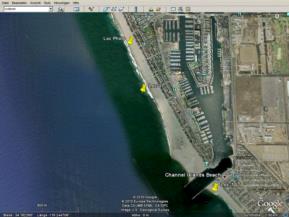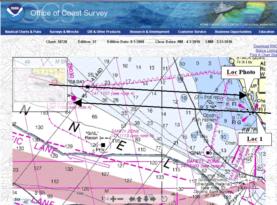
NavList:
A Community Devoted to the Preservation and Practice of Celestial Navigation and Other Methods of Traditional Wayfinding
Re: Digital Image CN Exercise
From: Marcel Tschudin
Date: 2010 Apr 6, 15:09 +0300
From: Marcel Tschudin
Date: 2010 Apr 6, 15:09 +0300
OK, Greg. I therefore proceeded with your Pixel scale of 0.097 Minutes of arc per Pixel corresponding to 0.001616667 degrees of arc per Pixel. The location obtained with the scale derived from the green disc will only be mentioned for reference. In the mean time the dip-error has been located and corrected. The formula was actually correct but only used to verify whether the object is above or below the visible horizon. I didn't remember that the results shown in apparent coordinates are provided relative to the astronomical horizon and not to the apparent one. The too high value which appeared in the output referred to the selected "standard location" which was different to those used for solving this problem. The rest seems now to be straight forward. The locations are shown in the attached screen shot of Google Earth and the location where the photo was taken in the NOAA chart. The horizon is claimed to be at 2468 Pixels below the UL (the image is actually cut at 2464 Px); the UL is therefore 3.989933333 degrees above the apparent horizon. At the given date and time: 3 April 2010, 01:57:41 UTC the local meteorological conditions are found in the History data for Oxnard, CA http://english.wunderground.com/history/airport/KOXR/2010/4/2/DailyHistory.html?req_city=NA&req_state=NA&req_statename=NA&MR=1 Temp: 13.9°C and Press: 1017.2 hPa using these data, the apparent heights above the horizon are as follows: At Loc 0, the location initially provided (aLat=34°10'N, aLon=119°14'W, Height of eye 13 ft.= 4 m), the sun's position would have been: UL = 3.997120833 degrees above the horizon (instead of 3.989933333). The photo must have been taken slightly south of this location where the sun sets slightly earlier. At Loc 1 (34.274415 N, 119.288867 W) which has been found by trial and error the UL of the sun corresponds with sufficient accuracy to the one where the photo could have been taken: UL = 3.9896 degrees above the horizon (instead of 3.9899). Regarding the different locations mentioned here see attached file "_All LOCs.gif" and "_Chart.gif". Finding the off-shore oil rig: Measuring the distances in x-direction between centre of the sun to the oil rig in the original photo: Sun: Right limb = 744 Px, Left limb = 418 Px, the Centre is at 581 Px Oil rig (about): Right edge = 146 Px, Left edge = 52 Px, the Centre is at 99 Px Angular distance between sun centre and oil rig centre: 482 Px = 0.779233333 degrees. Photo: Note: The azimuths are counted from South = 0 degrees to West = 90 degrees etc. The azimuth of the sun's centre is 93.90984 degrees (thus slightly north of west direction) The oil rig is about 0.779233333 degrees South of the sun's centre. The azimuth to the oil rig is therefore 93.13060667 degrees A line with this azimuth drawn from Loc 1 passes in about 14.2 km distance about 1.4 km south of the oil rig Gilda. By drawing a parallel line which crosses this oil rig one obtains at the coast the location "Loc Photo" which lies in the opposite direction of the initial Loc 0. So, something is still going wrong and I realise also what. My program calculates the apparent position of the centre of the sun. The refraction is calculated for this position to which I added half of the observed height of the flattened sun. This is likely to be slightly different from calculating the apparent position for the top of the sun. In an other part of my program I actually have provided the possibility to select a location relative to the body's shape from -1 (lower limb) to +1 (upper limb), but unfortunately not in this part where it would first have to be added. Regarding your "extra credit". The first could be done manually knowing the distance which is behind the apparent horizon. The second I have to pass since I'm not a bird watcher, I hardly can differentiate between a gull and a sparrow ;-) Marcel P.S: By using the different scale of 0.100 Minutes of arc per Pixel Loc 1 would be about 15 km further north, about 2.5 km after Ventura.








